特別展「京都 大報恩寺 快慶・定慶のみほとけ」
-
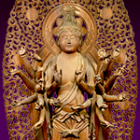
重要文化財 准胝観音菩薩立像(六観音菩薩像のうち)(部分) 肥後定慶作 鎌倉時代・貞応3年(1224) 大報恩寺蔵
1089ブログ「特別展『京都 大報恩寺 快慶・定慶のみほとけ』」 展覧会の見どころなどを紹介しています。
東京国立博物館 資料館 特別展「京都 大報恩寺 快慶・定慶のみほとけ」関連図書コーナー設置
展覧会のみどころ
大報恩寺の歴史と寺宝-大報恩寺と北野経王堂
聖地の創出―釈迦信仰の隆盛
六観音菩薩像と肥後定慶
大報恩寺の歴史と寺宝-大報恩寺と北野経王堂
大報恩寺は、平安京大内裏のすぐ北西に所在しました。そのほど近く、北野天満宮の西側には、創建が7世紀にさかのぼる古代寺院があったといい、平安遷都後はこの寺が桓武天皇ゆかりの寺として整備されるなど、古くから開かれた土地であったことが知られます。伝来は不明ですが、大報恩寺には平安時代前期に遡る千手観音菩薩立像が伝えられています。
このほかにも大報恩寺には、今は失われてしまった北野経王堂ゆかりの名宝も数多くのこされています。北野経王堂は足利義満によって建てられた仏堂で、室町将軍家があつい信仰を寄せました。五千帖を超す「北野経王堂一切経」や「傅大士坐像および二童子立像」は、北野社境内に位置し、経王堂管理下にあった輪蔵ゆかりの品です。こうした大報恩寺に伝来する数々の名宝を通して、この地で積み重ねられてきた歴史をうかがい知ることができます。
ここでは、大報恩寺とともに、大報恩寺がその運営に密接に関与した北野経王堂の歴史を紐解きます。
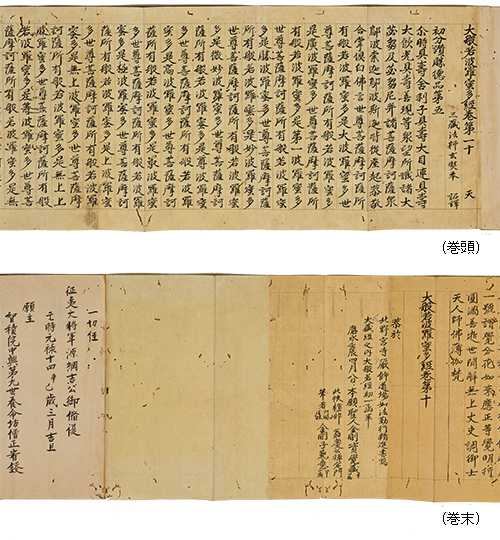  重要文化財 北野経王堂一切経 15世紀前半に日本各地の僧侶が分担して書写した5000部以上の仏教経典。北野社の境内で長く保管された。 |
  重要文化財 傅大士坐像および二童子立像 北野の経王堂にあった輪蔵(応永20年建立)の前に安置されていた像。傅大士は輪蔵を初めて造った人。現在の中国浙江省に生まれ、太建元年(569)に没した。両脇の童子、普建・普成は大士の子。脇侍頭部内側の銘により、院隆が応永25年に作ったことがわかる。 |
聖地の創出―釈迦信仰の隆盛
大報恩寺が建立された13世紀の前半は、人びとに仏の教えが届かず、仏法を実践する者すらいなくなる末法の世を強く実感させる時代でした。12世紀末より全国規模で起こった源氏と平氏の内乱、たび重なる大規模災害、なにより戦乱のさなかに東大寺の大仏が焼け崩れてしまったことは、仏法の破滅とそれと連動する王権の衰微を強く印象づけました。こうした時代背景のもと、仏教の教主である釈迦の教えに立ち返ろうとする動きが強くなり、釈迦信仰が隆盛しました。
天台僧の義空(1172~1241)は、釈迦は永久にこの世に存在し法を説くという『法華経』の教えにもとづいて、大報恩寺を創建しました。快慶作の十大弟子立像と、快慶の弟子、行快作の釈迦如来坐像が、今も本寺に伝わっています。本堂の上棟当時は、文殊菩薩・弥菩薩像も安置されていました。これらの尊像構成は、『法華経』での釈迦如来の説法を意図したものだと考えられます。
義空は、この世に常住して説法する釈迦を造ることによって、末法の世を生きる人びとを救う場を生み出したのでした。
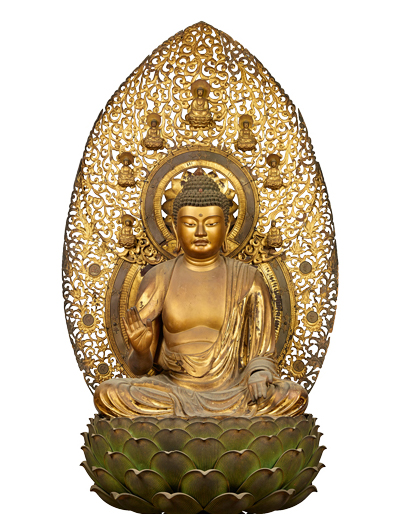  |
重要文化財 釈迦如来坐像[しゃかにょらいざぞう] 本堂内陣の須弥壇上に安置される、大報恩寺の秘仏本尊。台座・光背も、造像当初のものである。像内に朱書銘があり、鎌倉時代を代表する仏師快慶の高弟、行快の作であることがわかる。丸みの強い面部や目尻が上がった目のかたちなどに、行快の特徴がよくあらわれている。 |
 
重要文化財 十大弟子立像[じゅうだいでしりゅうぞう] 上段左から、阿難陀[あなんだ]、羅睺羅[らごら]、優婆離[うぱり]、阿那律[あなりつ]、迦旃延[かせんえん]、富楼那[ふるな]、須菩提[すぼだい]、大迦葉[だいかしょう]、目犍連[もくけんれん]、舎利弗[しゃりほつ] 釈迦の弟子のなかでも、とりわけ優れた人物を10人とりあげて、十大弟子と呼ぶ。十体が完存する遺品として貴重で、快慶工房で制作されたことがわかる。本堂の棟木(安貞元年・1227)に残された義空の願文によれば、「等身釈迦如来、弥勒、文殊、十大弟子形像」として安置されたようだ。 |
寺外初公開の秘仏「釈迦如来坐像」と快慶晩年の名品「十大弟子立像」を、特別に同じ空間で展示
大報恩寺の本尊で、同寺でも年に数回しか公開されない秘仏「釈迦如来坐像」(重要文化財)は、快慶の弟子・行快が残した数少ない貴重な仏像の一つです。そして、快慶が晩年に手がけた名品「十大弟子立像」(重要文化財)は、現在は同寺の霊宝殿に安置されていますが、当初は本堂にあり、本尊の「釈迦如来坐像」を囲むように安置されていました。本展では、釈迦とその10人の弟子を、当初の本堂での安置状況を考慮し、特別に同じ空間でご覧いただきます。
六観音菩薩像と肥後定慶
大報恩寺には、運慶一門の慶派仏師、定慶作の六観音菩薩像が伝来しています。六観音とは、聖観音・千手観音・馬頭観音・十一面観音・准胝観音(または不空羂索観音)・如意輪観音の総称で、地獄道や餓鬼道をはじめとする六道から人びとを救う仏として、平安時代以降に大変流行しました。本像は、中世に遡る六観音で、しかも光背、台座までも完存する唯一の作例です。
本像は、准胝観音の像内墨書銘によって、貞応三年(1224)に、定慶が造ったことがわかります。運慶の長男である湛慶より十歳ほど若い定慶は、運慶次世代の実力派仏師の一人でした。定慶は、運慶の作風をよく学び、仏像の体躯を破綻なくまとめあげる、相当な力量をもっていましたが、そればかりではなく、結い上げた髪の毛の柔らかな質感や束ねた髪束の毛先の複雑な動きの描写、空気をはらむ衣の描写や翻転する衣文表現など、細部にも目を見張る彫技を見せています。
本像がもつなまなましい実在感は、末法の世に生きる当時の人びとが、仏に切実に求めたものだったのかもしれません。
 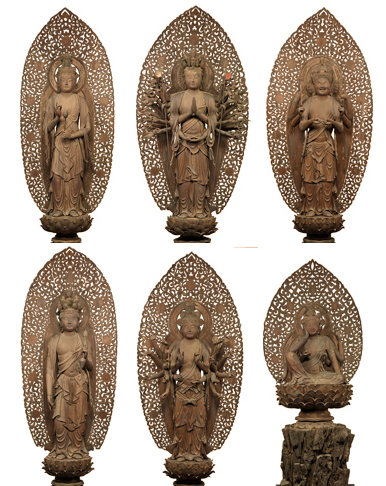
重要文化財 六観音菩薩像[ろくかんのんぼさつぞう] 上段左から、聖観音菩薩立像[しょうかんのんぼさつりゅうぞう]、千手観音菩薩立像[せんじゅかんのんぼさつりゅうぞう]、馬頭観音菩薩立像[ばとうかんのんぼさつりゅうぞう]、十一面観音菩薩立像[じゅういちめんかんのんぼさつりゅうぞう]、准胝観音菩薩立像[じゅんでいかんのんぼさつりゅうぞう]、如意輪観音菩薩坐像[にょいりんかんのんぼさつざぞう] 貞応3年(1224)、運慶一門の仏師、肥後定慶が主導して造った像。像内に定慶自筆の銘があった准胝観音に、髪束のふくらみや毛先の動きのもつ独特の質感描写や、衣がはらむ空気感を感じさせる衣文表現など、定慶の表現の特徴がよくうかがえる。
重要文化財「六観音菩薩像」の光背を会期後半に外し、背中も間近にご覧いただけます 運慶の弟子・肥後定慶作「六観音菩薩像」は、重要文化財に指定される唯一の六観音像です。台座も光背も造像当初のものを残し、その背面の隅々まで、精緻に彫られています。 本展では、「六観音菩薩像」を360度ご覧いただけるだけでなく、会期前半(~10月28日)は光背をつけた本来の姿で、会期後半(10月30日~)には光背を取り外し、その美しい背中も間近にご覧いただけます。会期前半と後半で、仏像の違う表情、魅力を堪能いただける、当館史上初の試みです。 |
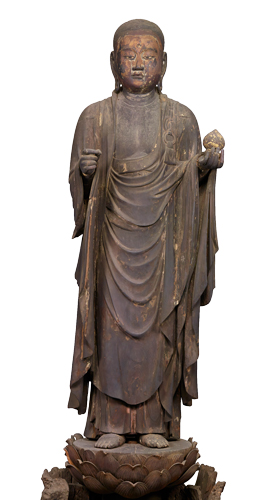  |
地蔵菩薩立像[じぞうぼさつりゅうぞう] 寛文10年(1670)、北野社(現、北野天満宮)の南にあった経王堂から、六観音菩薩像とともに大報恩寺に移された。面部の造作などが、六観音のうち准胝観音とよく似ている。六観音と構造や大きさも共通することから、両者1対として造られた可能性がある。 |
大報恩寺とは

1220年に義空上人によって開創された真言宗智山派の寺院で、「千本釈迦堂」の名で知られています。その名前の由来は、本堂の行快作の本尊「釈迦如来坐像」(重要文化財)が古来より厚く信仰されていること、近くに南北に走る千本通があることなど、諸説あります。年中行事も盛んで、2月の「おかめ福節分」、春の境内のしだれ桜、12月の大根炊きなど、京の四季を彩る寺院として、地元だけでなく多くの観光客にも親しまれています。「おかめ発祥の地」ともいわれており、縁結び、夫婦円満、子授けにご利益があると言われています。
写真:本堂(国宝)
開催概要 |
|||||||||||||||||||
| 会 期 | 2018年10月2日(火) ~12月9日(日) | ||||||||||||||||||
| 会 場 | 東京国立博物館 平成館 特別展示室第3室・第4室(上野公園) | ||||||||||||||||||
| 開館時間 | 9:30~17:00(入館は閉館の30分前まで) (ただし、会期中の金曜・土曜、10月31日(水)、11月1日(木)は21:00まで開館) |
||||||||||||||||||
| 休館日 | 月曜日(ただし10月8日(月・祝)は開館、10月9日(火)は休館) | ||||||||||||||||||
| 観覧料金 | 一般1400円(1200円/1200円)、大学生1000円(800円/800円)、高校生800円(600円/600円) 中学生以下無料
「マルセル・デュシャンと日本美術」との2展セット観覧料金 一般2000円(1800円)
|
||||||||||||||||||
| 交 通 | JR上野駅公園口・鶯谷駅南口より徒歩10分 東京メトロ銀座線・日比谷線上野駅、千代田線根津駅、京成電鉄京成上野駅より徒歩15分 |
||||||||||||||||||
| 主 催 | 東京国立博物館、大報恩寺、読売新聞社 | ||||||||||||||||||
| 協 賛 | トヨタ自動車、あいおいニッセイ同和損害保険 | ||||||||||||||||||
| カタログ・音声ガイド | 展覧会カタログ(2,300円)は、平成館会場内、およびミュージアムショップにて販売しています。音声ガイド(日本語、英語、中国語、韓国語)は520円でご利用いただけます。 | ||||||||||||||||||
| お問合せ | 03-5777-8600 (ハローダイヤル) | ||||||||||||||||||
| 展覧会公式サイト | https://artexhibition.jp/kaikei-jokei2018/ 展覧会公式サイトは会期終了時をもって終了いたしました。 |
||||||||||||||||||
